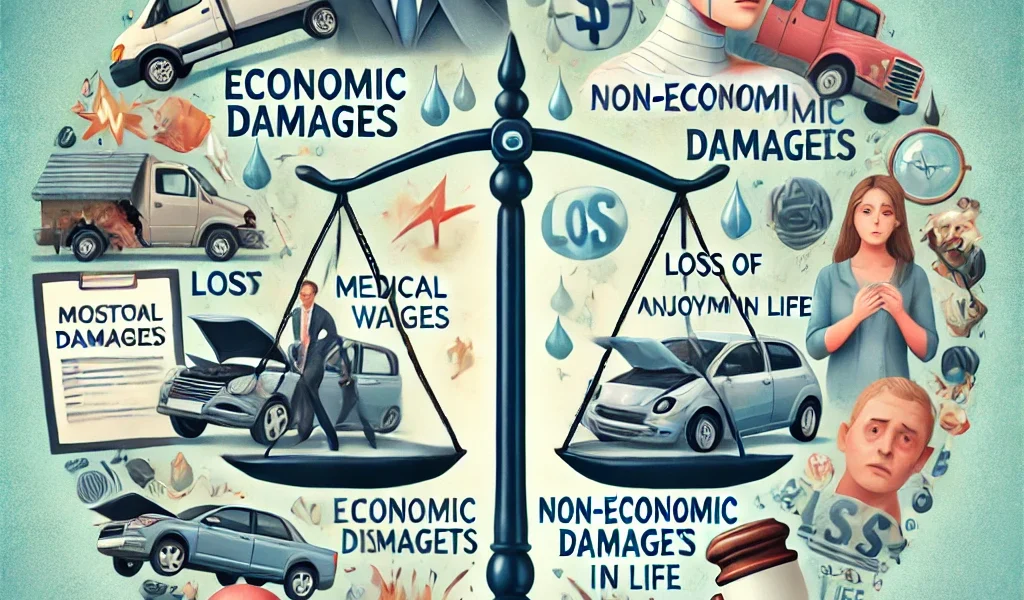Introduction
When a person suffers a personal injury due to someone else’s negligence, they may be entitled to financial compensation. However, not all damages are the same. In legal terms, compensation is typically divided into two main categories: economic damages and non-economic damages. Understanding these categories can help personal injury victims and their attorneys pursue fair and full compensation for their losses.
This article will provide an in-depth analysis of economic vs. non-economic damages, examples of each, how they are calculated, and what factors influence their value.
What Are Economic Damages?
Economic damages, also known as special damages, refer to the quantifiable financial losses that a victim suffers due to their injury. These losses have a specific dollar value and can be documented through receipts, bills, and other financial records.
Common Types of Economic Damages
- Medical Expenses
- Hospital stays, surgeries, and medical treatments
- Prescription medications
- Physical therapy and rehabilitation
- Medical devices (e.g., wheelchairs, prosthetics)
- Future medical expenses related to the injury
- Lost Wages and Income
- Compensation for time missed at work due to the injury
- Reduced earning capacity if the victim is unable to return to their previous job
- Loss of employment benefits (e.g., health insurance, retirement contributions)
- Property Damage
- Repair or replacement costs for damaged property (e.g., vehicle repairs after a car accident)
- Other Out-of-Pocket Expenses
- Travel costs for medical appointments
- Home modifications for disability accommodations
- Hiring help for household chores or childcare
How Are Economic Damages Calculated?
Economic damages are calculated based on actual financial records, such as medical bills, pay stubs, and invoices. Future costs (e.g., long-term medical care) are often estimated using expert testimony from medical professionals and financial analysts.
What Are Non-Economic Damages?
Non-economic damages, also known as general damages, refer to the subjective, non-monetary losses that a victim experiences due to their injury. Unlike economic damages, these losses do not have a clear dollar value and are more difficult to quantify.
Common Types of Non-Economic Damages
- Pain and Suffering
- Physical pain caused by the injury and ongoing discomfort
- Chronic pain or long-term suffering
- Emotional Distress
- Anxiety, depression, or post-traumatic stress disorder (PTSD)
- Mental anguish caused by the trauma of the accident
- Loss of Enjoyment of Life
- Inability to participate in hobbies, sports, or other enjoyable activities
- Decreased quality of life due to disability or chronic pain
- Loss of Consortium
- Impact on personal relationships, including the loss of companionship or affection
- Spouses or family members may claim this type of damage in certain cases
How Are Non-Economic Damages Calculated?
Since non-economic damages are subjective, courts use different methods to determine their value:
- Multiplier Method: The total economic damages are multiplied by a number (typically between 1.5 and 5) based on the severity of the injury.
- Per Diem Method: A specific daily amount is assigned for pain and suffering, multiplied by the number of days the victim is expected to suffer.
- Jury Discretion: In some cases, a jury determines a fair amount based on case evidence and testimony.
Key Differences Between Economic and Non-Economic Damages
| Factor | Economic Damages | Non-Economic Damages |
|---|---|---|
| Definition | Financial losses with a clear dollar value | Subjective losses without a direct monetary value |
| Examples | Medical bills, lost wages, property damage | Pain and suffering, emotional distress, loss of enjoyment |
| Evidence Needed | Bills, receipts, pay stubs, financial records | Medical reports, psychological evaluations, witness testimony |
| Calculation Method | Based on documented expenses | Estimated using multiplier or per diem methods |
| Cap Limitations | Generally no limits (except for punitive damages) | Some states have caps on non-economic damages |
Factors That Influence Compensation Amounts
Several factors can impact the amount a victim receives in both economic and non-economic damages:
- Severity of the Injury
- More severe injuries typically lead to higher compensation.
- Permanent disabilities result in greater economic and non-economic losses.
- Impact on Daily Life
- If an injury prevents a victim from working or enjoying life, non-economic damages may be higher.
- Level of Fault
- In some states, comparative negligence rules reduce compensation if the victim shares some fault for the accident.
- Insurance Policy Limits
- If the at-fault party has limited insurance coverage, it may cap the amount of recoverable damages.
- Legal Representation
- Having an experienced personal injury attorney can significantly impact the settlement outcome.
Are There Limits on Personal Injury Compensation?
Some states impose caps (limits) on the amount of non-economic damages a victim can recover. These caps typically apply to medical malpractice cases but may also affect general personal injury claims.
- Example: California has a $250,000 cap on non-economic damages for medical malpractice cases.
- Some states do not have any caps, allowing victims to recover full compensation.
Conclusion
Understanding the difference between economic and non-economic damages is crucial for anyone pursuing a personal injury claim. While economic damages cover direct financial losses, non-economic damages address emotional and physical suffering.
If you have suffered an injury due to someone else’s negligence, it’s important to consult with a qualified personal injury attorney to ensure you receive fair compensation for both economic and non-economic losses.
Disclaimer: This article is for informational purposes only and does not constitute legal advice. Always consult a legal professional for advice regarding your specific case.




